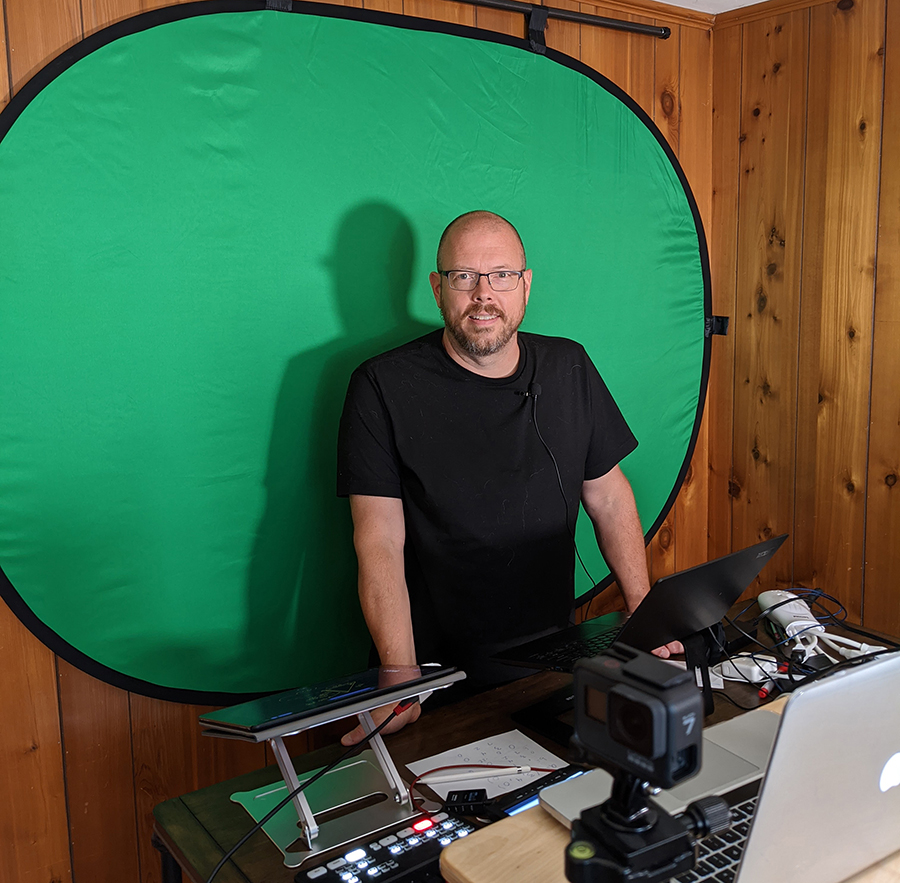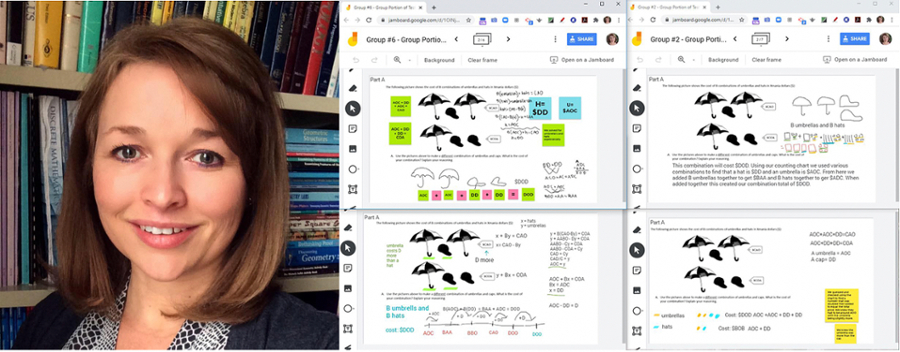
Miami faculty adapt to online and hybrid teaching; developing tools and techniques that will serve students far beyond COVID-19 pandemic
By Cliff Peale, director of executive communications

Norm Krumpe in the home studio he shares with Jane Keiser (image courtesy Krumpe).
Across all of Miami University’s campuses, faculty are changing the way they teach.
- In the nursing labs at Miami Regionals, Tina Andrews-Parks used help from the E-campus unit on the Hamilton and Middletown campuses to familiarize herself with SpeedGrader, where she can tabulate and analyze the responses to each question in seconds for her online class. “I won’t go backwards to paper testing,” she said.
- In information systems and analytics, Bob Leonard uses software that enables students to analyze larger data sets in his online courses. "It’s going to be great bringing newly developed tools back to the classroom, because students will have that (online) scaffolding in addition to their professor as a resource,” he said.
- In political science, Monica Schneider has recruited speakers to address her Campaigns and Elections class by video. “Some of these are speakers I would never be able to bring into my class (in Oxford),” she said.
- In computer science and software engineering, Norm Krumpe and his wife, math professor Jane Keiser, have set up their own basement studio for online classes, complete with green screen and audio-visual switcher. “I think I’ll keep using videos so that classroom time can focus on hands-on activities,” he said.
- In mathematics, Suzanne Harper uses the interactive whiteboards in Google Jamboard to simultaneously monitor nine student groups in one class, a level of engagement she could not duplicate face-to-face. “I was trying to find a way to mimic that (face-to-face) environment online, with some collaborative spaces they could work in,” she said.
Innovation, care and connection

Suzanne Harper and an example of the Google Jamboards used by student groups in her class (image courtesy Harper).
“Faculty are applying a lot of scrutiny to the way they teach and learn,” said Ellen Yezierski, professor of chemistry and director of the CTE. “Students are engaged in some carefully shaped high-quality online experiences. The innovation is great, but it’s not enough. The care and the connection are things that have distinguished our faculty, and those are still the most important elements.”
The common thread is plain: Miami faculty are adapting to online and hybrid teaching to ensure a commitment to student success that has differentiated Miami for generations. While Miami classes look radically different than they did a year ago, faculty and students are capitalizing on new tools and techniques to serve students, in many cases providing efficiencies or opportunities they did not previously envision.
In many ways, the transformation forced by COVID-19 is accelerating the adoption of innovative and effective teaching practices, such as the “flipped classroom,” where group work and lectures take place remotely or online and valuable face-to-face time is reserved for impactful, active engagement with students. In that way, the benefits of this volatile period will extend well past the day when students fully return to Miami classrooms, Provost Jason Osborne said.
“Through the transition to remote learning and now the return to face-to-face and hybrid classes, Miami students and faculty have upheld our exceptionally high standards of academic excellence,” Osborne said. “The creativity and innovation we are seeing now will serve students well in the future as we engage even more deeply, both online and in person.”
Miami has enabled that transformation with resources to help faculty learn new skills and give them access to technical tools. During the summer, more than 150 Miami faculty participated in either networking or online education sessions through the CTE.

An example of CTE workshops offered this week.
Ryan Baltrip, director of digital learning initiatives and head of Miami’s eLearning unit, said there is an ongoing “awakening” among faculty about how technology and new techniques can improve their engagement with students.
Starting in March, eLearning offered training sessions and A-to-Z checklists for online learning. Preparing for fall, eLearning offered classes on the basics of teaching and learning online, as well as one-on-one support for high-priority classes. More than 540 Miami faculty participated.
“They’re learning new tools and new approaches,” Baltrip said. “The research says that people who go through this kind of learning, it actually improves their on-campus teaching. The secret is, they’re focused more on learning about teaching.”
The eLearning unit continues to grow, expecting to add six positions to the current staff of nearly a dozen.
The Howe Center for Writing Excellence conducted seminars for faculty members starting in March and extending through the summer on promoting “deep online learning.”
“Now that you’ve had all of this training in how to teach good writing, let’s learn how to innovate in an online space,” said Elizabeth Wardle, director. “What can we do online that we can’t do in person?”
